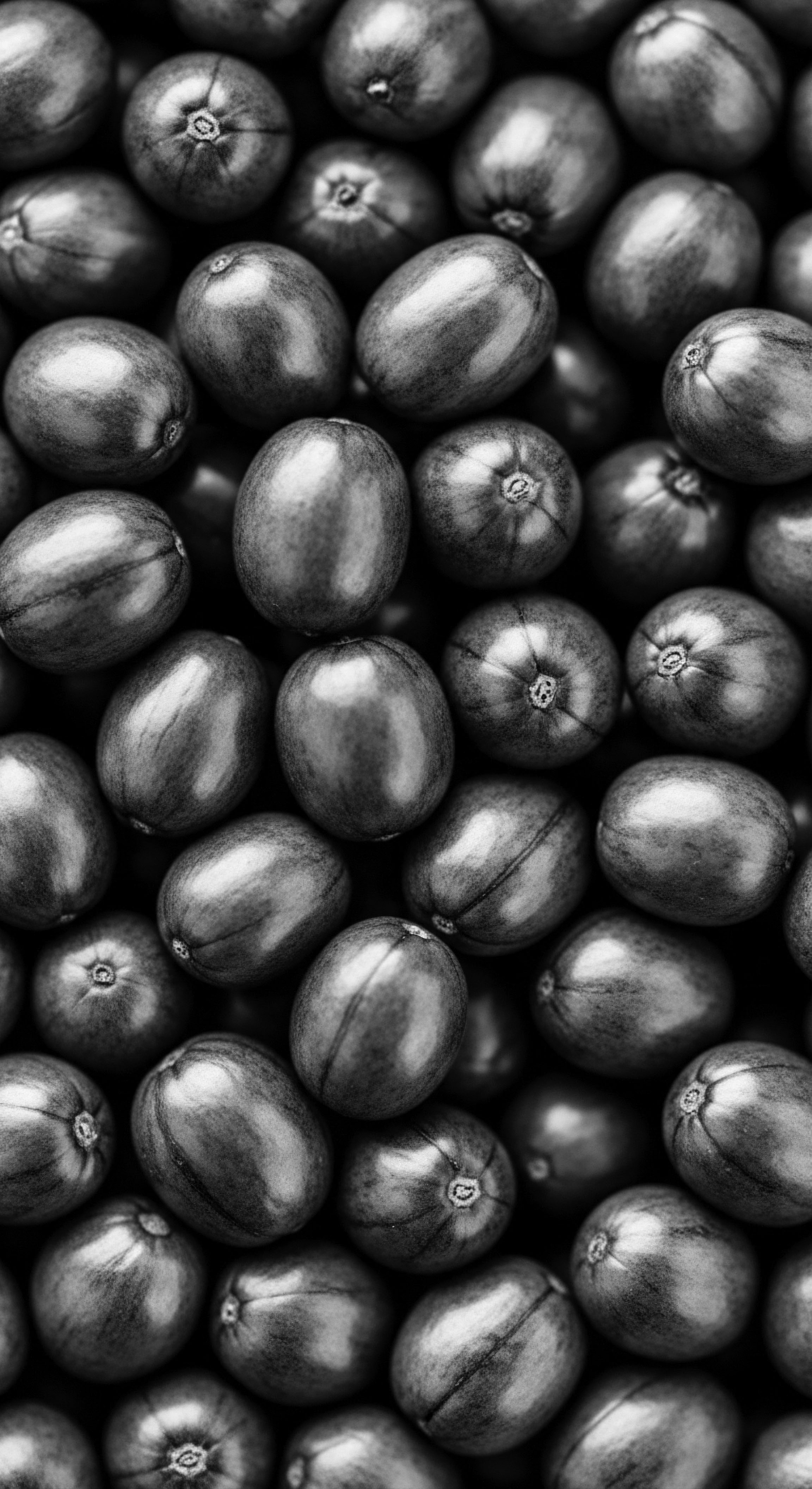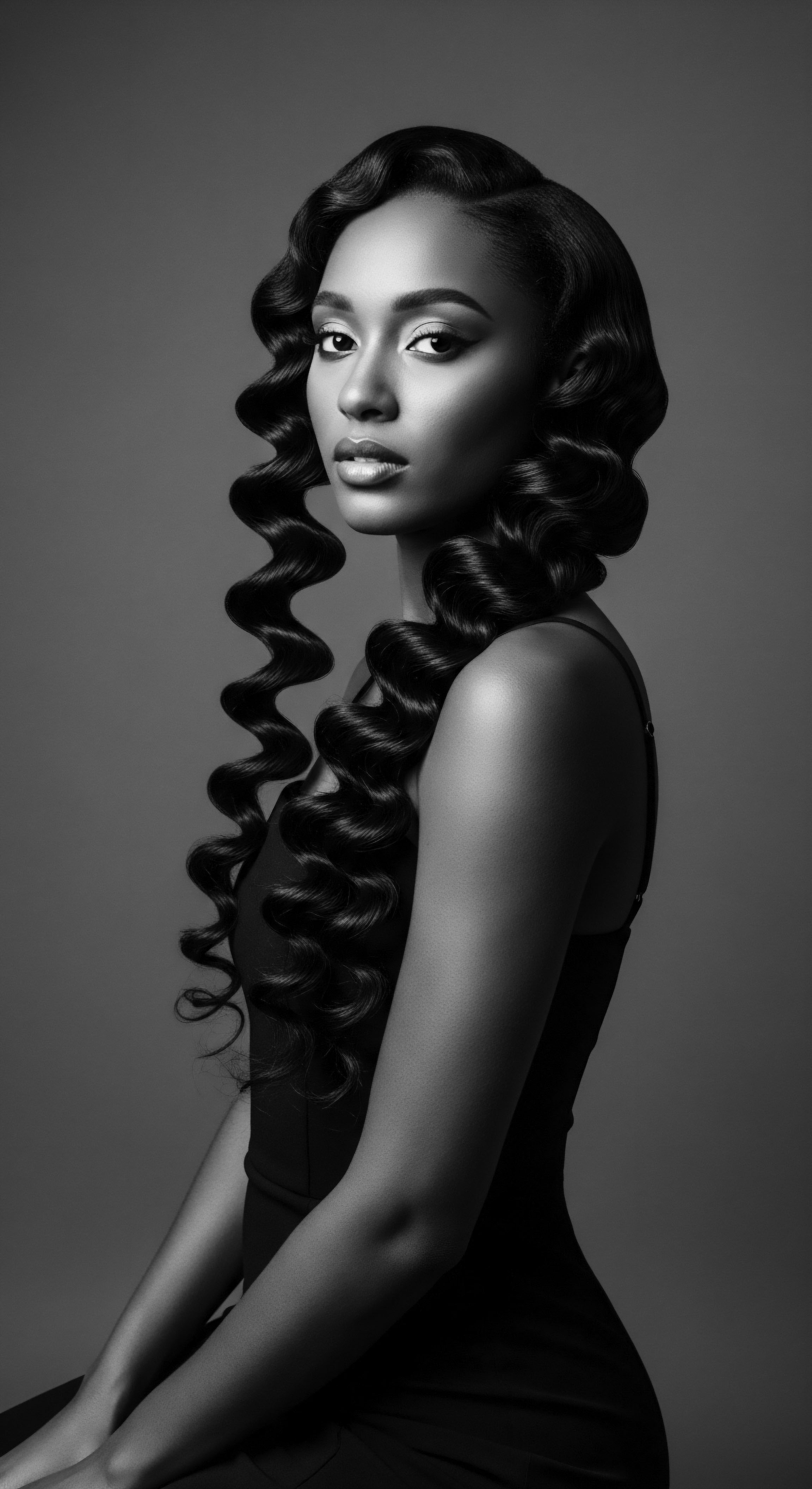
Fundamentals
The essence of hair’s vibrancy, its deep hues, and its subtle shifts in tone, originates from a remarkable biological process known as Melanin Synthesis. This fundamental biological operation represents the creation of melanin, the very pigment that gives hair its color. Without melanin, hair would appear translucent or white, reflecting light rather than absorbing it to reveal its inherent shade.
The significance of this process extends far beyond mere aesthetics; it speaks to the protective qualities of hair, its resilience, and its deep connection to ancestral heritage and environmental adaptation. Melanin is a complex polymer derived from the amino acid Tyrosine, produced and stored within specialized cellular structures called Melanosomes, which reside in cells known as Melanocytes within the hair follicles.

The Two Primary Pigments of Hair
Within the intricate architecture of each hair strand, two principal forms of melanin work in concert to compose the spectrum of human hair colors:
- Eumelanin ❉ This variety of melanin imparts shades ranging from rich brown to deep black. Hair with higher concentrations of eumelanin tends to be darker and offers more robust protection against the sun’s ultraviolet rays.
- Pheomelanin ❉ This pigment lends hair its warmer, lighter tones, from yellow to fiery red. Hair that exhibits a predominance of pheomelanin will often display golden, auburn, or reddish hues.
The specific blend and concentration of these two pigments within the hair shaft determine an individual’s natural hair color, a unique genetic signature passed down through generations.

Melanin’s Role Beyond Color
While melanin’s role in pigmentation is widely acknowledged, its purpose extends to protective functions. Melanin absorbs harmful UV radiation, acting as a natural shield for the cells within the hair follicle and scalp. This protective quality has held profound importance for ancestral populations living in diverse climates, particularly those exposed to intense sunlight. The deep, rich tones found in many textured hair types, often a result of higher eumelanin content, serve as a testament to this ancient biological defense mechanism.
Melanin Synthesis is the biological orchestration behind hair’s color, a process deeply intertwined with our ancestral lineage and environmental resilience.

The Initial Steps of Melanin Creation
The journey of melanin begins with the amino acid tyrosine. Within the melanocytes, an enzyme called Tyrosinase acts as a catalyst, initiating a series of chemical reactions that convert tyrosine into various intermediate compounds. These intermediates then undergo further transformations and polymerization, culminating in the formation of eumelanin and pheomelanin. The intricate control of this biochemical pathway, influenced by genetic factors, dictates the precise type and amount of melanin produced, ultimately defining the unique shade of each strand.

Intermediate
Understanding Melanin Synthesis at a deeper level reveals a complex interplay of cellular processes, genetic predispositions, and environmental influences that collectively shape the rich spectrum of hair colors, particularly within the context of textured hair heritage. This intricate biological explanation offers a clearer interpretation of why hair presents with such diverse shades and how these variations connect to the ancestral narratives woven into our very being.

The Cellular Choreography of Pigment Production
The production of melanin, known as Melanogenesis, is a carefully orchestrated process occurring within the melanocytes, cells residing at the base of the hair follicle, in the hair bulb. These specialized cells contain melanosomes, tiny organelles where the magic of pigment creation unfolds. Once synthesized, the melanin granules are then transferred from the melanocytes to the keratinocytes, the primary cells that make up the hair shaft. It is within these keratinocytes that the melanin takes its place, determining the hair’s visible color and its protective qualities.
The size, shape, and distribution of these melanosomes also contribute to the appearance of hair color and texture. For instance, the melanosomes in darker, more textured hair types tend to be larger and more densely packed, influencing how light interacts with the hair strand and contributing to its inherent luster.

Genetic Blueprints and Ancestral Echoes
The specific balance between eumelanin and pheomelanin, and thus the resulting hair color, is largely determined by genetics. A key player in this genetic orchestration is the Melanocortin 1 Receptor (MC1R) Gene. Variations in this gene can significantly influence the type and quantity of melanin produced. For example, an active MC1R gene tends to promote the production of eumelanin, leading to darker hair shades, while an inactive or mutated MC1R gene can result in higher pheomelanin production, yielding lighter or red hair.
This genetic inheritance carries the echoes of ancestral migrations and adaptations. Populations that historically lived in regions with high sun exposure often possess a genetic predisposition for higher eumelanin production, providing natural photoprotection for both skin and hair. This is particularly relevant for understanding the deep, rich tones prevalent in many Black and mixed-race hair experiences, where melanin offers an inherent shield against environmental stressors.

Beyond Pigment ❉ Melanin’s Structural Significance
The presence of melanin extends beyond merely providing color; it contributes to the structural integrity and resilience of the hair strand. Melanin’s complex polymeric nature helps to absorb and dissipate harmful ultraviolet radiation, protecting the hair from damage. This inherent protection is a testament to the wisdom embedded in our ancestral hair, a natural shield against the elements that has been passed down through generations. The hair of individuals with higher eumelanin content often exhibits greater resistance to environmental degradation compared to lighter hair types.
Melanogenesis, the process of melanin creation, is a cellular dance deeply informed by genetic inheritance, revealing the ancestral blueprint of hair’s color and resilience.
Consider the traditional hair care practices of the Basara Women of Chad, who are renowned for their exceptionally long and healthy hair. Their ritualistic use of Chebe Powder, a blend of natural herbs and seeds, does not directly alter melanin synthesis, yet it speaks to a profound ancestral understanding of hair health and length retention. Chebe powder works by coating the hair shaft, sealing in moisture, strengthening the strands, and preventing breakage, thereby allowing the hair to reach its full potential length.
This traditional approach, passed down through generations, underscores a collective ancestral wisdom that prioritized the preservation and nourishment of textured hair, recognizing its inherent strength and beauty, irrespective of direct melanin modification. The continuous application of Chebe powder, often intertwined with community bonding rituals, highlights a deep respect for hair as a living extension of self and heritage.
| Traditional Practice/Ingredient Chebe Powder (Chad) |
| Cultural Context Used by Basara women for length retention and strength, passed down through generations as a communal ritual. |
| Connection to Melanin/Hair Health Supports hair health and minimizes breakage, allowing natural hair with its inherent melanin to thrive and reach significant lengths. While not directly affecting melanin synthesis, it preserves the integrity of melanin-rich hair. |
| Traditional Practice/Ingredient Henna (Ancient Egypt, India, Middle East) |
| Cultural Context Used for reddish-brown hair dye, often symbolizing status or spiritual connection. |
| Connection to Melanin/Hair Health Temporarily stains the keratin in the hair, adding a layer of color over existing melanin, and can offer conditioning benefits, thereby protecting the hair shaft where melanin resides. |
| Traditional Practice/Ingredient Amla (Indian Gooseberry) |
| Cultural Context A staple in Ayurvedic practices for hair health, consumed and applied topically. |
| Connection to Melanin/Hair Health Rich in Vitamin C and antioxidants, it protects melanocytes from oxidative damage and encourages melanin production, supporting natural hair pigmentation and delaying premature graying. |
| Traditional Practice/Ingredient Shea Butter (Various African Tribes) |
| Cultural Context Used for moisturizing and protecting hair from harsh environmental conditions. |
| Connection to Melanin/Hair Health Forms a protective barrier on the hair, aiding in moisture retention and physical protection, which helps maintain the health of melanin-containing strands against environmental stressors. |
| Traditional Practice/Ingredient These practices underscore a global ancestral understanding of hair's vitality, often complementing melanin's inherent protective and aesthetic contributions to textured hair heritage. |

Academic
Melanin Synthesis, in its academic interpretation, represents a profound biochemical pathway, an oxidation and polymerization process of the amino acid Tyrosine, culminating in the production of diverse melanin biopolymers. This process, termed Melanogenesis, occurs within specialized organelles known as Melanosomes, contained within the Melanocytes of the hair follicle bulb. The nuanced delineation of this process extends beyond mere pigmentation, offering deep insights into genetic predispositions, cellular regulation, and the adaptive evolution of human hair phenotypes, particularly those with rich textured hair. The meaning of melanin synthesis, from an academic vantage, encompasses not only the molecular mechanics of color but also its profound significance in photoprotection, immunological responses, and even its indirect connections to neurological functions, as neuromelanin is found in the brain.

The Biochemical Architecture of Melanin Formation
The synthesis of melanin is a multi-stage enzymatic cascade. The initial, rate-limiting step involves the enzyme Tyrosinase, which catalyzes the hydroxylation of tyrosine to 3,4-dihydroxyphenylalanine (DOPA) and the subsequent oxidation of DOPA to DOPAquinone. From DOPAquinone, the pathway diverges, leading to the formation of two primary types of melanin ❉ Eumelanin and Pheomelanin.
Eumelanin, a dark brown to black pigment, arises from the cyclization and polymerization of DOPAquinone derivatives, specifically 5,6-dihydroxyindole (DHI) and 5,6-dihydroxyindole-2-carboxylic acid (DHICA). Pheomelanin, responsible for reddish-yellow hues, is formed when DOPAquinone reacts with cysteine, leading to the formation of cysteinyl-DOPA, which then polymerizes into benzothiazine units.
The precise ratio and distribution of these two melanin types within the cortical cells of the hair shaft determine the vast array of human hair colors. The morphology of melanosomes—their size, shape, and degree of melanization—also contributes significantly to the optical properties of hair, influencing how light is absorbed and scattered, thereby affecting the perceived color and luster of the hair.

Genetic and Epigenetic Regulation of Melanogenesis
The regulation of melanin synthesis is under stringent genetic control, with numerous genes influencing the quantity, type, and distribution of pigments. The Melanocortin 1 Receptor (MC1R) Gene is a particularly well-studied locus, as its allelic variations are strongly correlated with hair color phenotypes. An active MC1R receptor typically signals for eumelanin production, leading to darker hair. Conversely, certain loss-of-function mutations in MC1R can shift melanogenesis towards pheomelanin production, resulting in red or lighter hair.
Beyond single gene effects, complex polygenic interactions and epigenetic modifications also modulate melanin synthesis throughout an individual’s lifespan. Environmental factors, such as ultraviolet radiation exposure, can stimulate melanocyte activity, leading to increased melanin production as a protective response. The gradual decrease in melanocyte activity with age, attributed to the diminished proliferative capacity of melanocyte stem cells, explains the widespread phenomenon of hair graying.
Melanin Synthesis, viewed academically, is a complex biochemical process influenced by genetics and environment, defining hair color and its protective capabilities.

The Interconnectedness ❉ Melanin Synthesis and Textured Hair Heritage
The academic exploration of melanin synthesis offers a profound lens through which to understand the unique characteristics and heritage of textured hair. Hair types prevalent in populations of African and mixed-race descent often possess a higher concentration of eumelanin, which provides superior natural protection against solar UV radiation. This inherent photoprotective quality has been a critical adaptive advantage for ancestral communities residing in high-UV environments. The density and distribution of melanosomes in tightly coiled hair structures also contribute to its unique strength and resilience, though these characteristics can also make textured hair more prone to dryness and breakage if not adequately cared for.
A historical example that illuminates the profound connection between melanin’s protective qualities and ancestral hair practices is the traditional use of protective styling and natural emollients across various African communities. For centuries, diverse African societies, such as the Wolof, Mende, Mandingo, and Yoruba, have viewed hair as a powerful symbol of identity, status, and spiritual connection. The practices of braiding, twisting, and coiling hair, often accompanied by the application of natural oils and butters, served not only aesthetic purposes but also provided physical protection for the hair shaft, preserving its moisture and minimizing damage from environmental elements. This meticulous care, often passed down through generations, tacitly acknowledged the importance of maintaining the integrity of melanin-rich hair, allowing it to flourish and retain its inherent strength.
For instance, the practice of braiding rice seeds into hair during the transatlantic slave trade by African women, particularly rice farmers, served as a means of survival and cultural preservation. These braided patterns also acted as maps, guiding escapes from plantations. This specific historical instance underscores how deeply hair care, and by extension the preservation of hair’s natural qualities like its melanin content, was interwoven with survival, resistance, and the continuity of cultural identity, even under extreme duress. The knowledge embedded in these ancestral practices, often rooted in an intuitive understanding of hair’s needs, predates modern scientific explanations of melanin’s protective role, yet aligns perfectly with them.
The implications of melanin synthesis extend into modern hair care and public health, particularly for individuals with textured hair. The heightened eumelanin content in darker hair, while offering UV protection, also influences how hair responds to chemical treatments and heat styling. Oxidative processes, such as those involved in chemical lightening, target melanin.
Eumelanin, being more soluble, breaks down first during lightening processes, revealing the underlying pheomelanin tones. This scientific understanding provides a foundational basis for developing culturally attuned hair care strategies that honor the unique biological properties of textured hair, moving beyond universalized approaches that may not adequately address its specific needs.

Reflection on the Heritage of Melanin Synthesis
As we conclude this exploration of Melanin Synthesis, we recognize that its scientific definition merely scratches the surface of its true significance. For Roothea, and for all who cherish the legacy of textured hair, Melanin Synthesis is more than a biochemical pathway; it is an ancestral whisper, a living testament to resilience, adaptation, and beauty. The deep, varied hues that grace Black and mixed-race hair are not random occurrences but are the vibrant manifestations of generations of wisdom, of lives lived in harmony with the sun and earth, and of an enduring spirit that finds expression in every curl and coil. This inherent pigmentation speaks to a legacy of strength, providing a natural shield against the very elements that shaped our forebears.
The understanding of melanin’s creation allows us to appreciate the meticulous care traditions, the communal rituals, and the deep reverence for hair that have always been central to these cultures. It reminds us that our hair is not just a crown; it is a profound meditation on heritage, a continuous thread connecting us to the source of our being and the vibrant tapestry of our shared past.

References
- Chang, T. S. (2009). Melanogenesis ❉ A comprehensive review of the synthesis and regulation of melanin. Journal of Dermatology, 36(10), 557-571.
- D’Orazio, J. A. et al. (2006). Melanocortin 1 Receptor and the Genetics of Red Hair. Annual Review of Genetics, 40, 129-144.
- Giacomoni, P. U. & Maibach, H. I. (Eds.). (2018). Hair and Hair Diseases. Springer.
- Jablonski, N. G. (2006). Skin ❉ A Natural History. University of California Press.
- Nordlund, J. J. et al. (Eds.). (2006). The Pigmentary System ❉ Physiology and Pathophysiology. Blackwell Publishing.
- Olumide, Y. M. & Akinkugbe, A. O. (Eds.). (2010). Textbook of Dermatology in Tropical Africa. Blackwell Publishing.
- Petersen, S. (2022). The Origins of Chébé. The Zoe Report.
- Robins, A. H. (1995). Biological Perspectives on Human Pigmentation. Cambridge University Press.
- Souto, E. B. et al. (2018). Melanin and melanogenesis ❉ A review of recent advances. International Journal of Molecular Sciences, 19(11), 3465.
- Tobin, D. J. (2019). Hair in Toxicology ❉ An Important Bio-Matrix. Royal Society of Chemistry.
